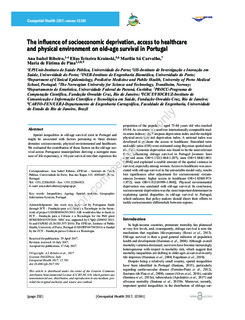| dc.contributor.author | Ribeiro, Ana Isabel | |
| dc.contributor.author | Krainski, Elias Teixeira | |
| dc.contributor.author | Carvalho, Marilia Sá | |
| dc.contributor.author | de Pina, Maria de Fátima | |
| dc.date.accessioned | 2018-08-27T07:45:05Z | |
| dc.date.available | 2018-08-27T07:45:05Z | |
| dc.date.created | 2018-03-06T09:44:31Z | |
| dc.date.issued | 2017 | |
| dc.identifier.citation | Geospatial Health. 2017, 12 (2), 252-263. | nb_NO |
| dc.identifier.issn | 1827-1987 | |
| dc.identifier.uri | http://hdl.handle.net/11250/2559370 | |
| dc.description.abstract | Spatial inequalities in old-age survival exist in Portugal and might be associated with factors pertaining to three distinct domains: socioeconomic, physical environmental and healthcare. We evaluated the contribution of these factors on the old-age survival across Portuguese municipalities deriving a surrogate measure of life expectancy, a 10-year survival rate that expresses the proportion of the population aged 75-84 years old who reached 85-94. As covariates we used two internationally comparable multivariate indexes: the European deprivation index and the multiple physical environmental deprivation index. A national index was developed to evaluate the access to healthcare. Smoothed rates and odds ratios (OR) were estimated using Bayesian spatial models. Socioeconomic deprivation was found to be the most relevant factor influencing old-age survival in Portugal [women: least deprived areas OR=1.132(1.064-1.207); men OR=1.044(1.001-1.094)] and explained a sizable amount of the spatial variance in survival, especially among women. Access to healthcare was associated with old-age survival in the univariable model only; results lost significance after adjustment for socioeconomic circumstances [women: higher access to healthcare OR=1.020(0.973-1.072); men OR=1.021(0.989-1.060)]. Physical environmental deprivation was unrelated with old-age survival. In conclusion, socioeconomic deprivation was the most important determinant in explaining spatial disparities in old-age survival in Portugal, which indicates that policy makers should direct their efforts to tackle socioeconomic differentials between regions. | nb_NO |
| dc.language.iso | eng | nb_NO |
| dc.publisher | PAGEpress | nb_NO |
| dc.rights | Navngivelse-Ikkekommersiell 4.0 Internasjonal | * |
| dc.rights.uri | http://creativecommons.org/licenses/by-nc/4.0/deed.no | * |
| dc.title | The influence of socioeconomic deprivation, access to healthcare and physical environment on old-age survival in Portugal | nb_NO |
| dc.type | Journal article | nb_NO |
| dc.type | Peer reviewed | nb_NO |
| dc.description.version | publishedVersion | nb_NO |
| dc.source.pagenumber | 252-263 | nb_NO |
| dc.source.volume | 12 | nb_NO |
| dc.source.journal | Geospatial Health | nb_NO |
| dc.source.issue | 2 | nb_NO |
| dc.identifier.doi | 10.4081/gh.2017.581 | |
| dc.identifier.cristin | 1570722 | |
| dc.description.localcode | © Copyright A.I. Ribeiro et al., 2017. This article is distributed under the terms of the Creative Commons Attribution Noncommercial License (CC BY-NC 4.0) which permits any noncommercial use, distribution, and reproduction in any medium, provided the original author(s) and source are credited. | nb_NO |
| cristin.unitcode | 194,63,15,0 | |
| cristin.unitname | Institutt for matematiske fag | |
| cristin.ispublished | true | |
| cristin.fulltext | original | |
| cristin.qualitycode | 1 | |

